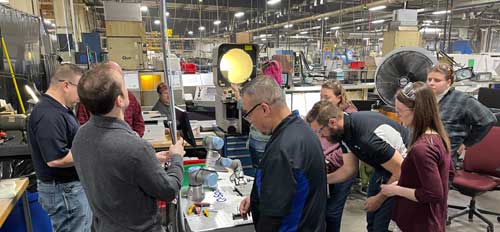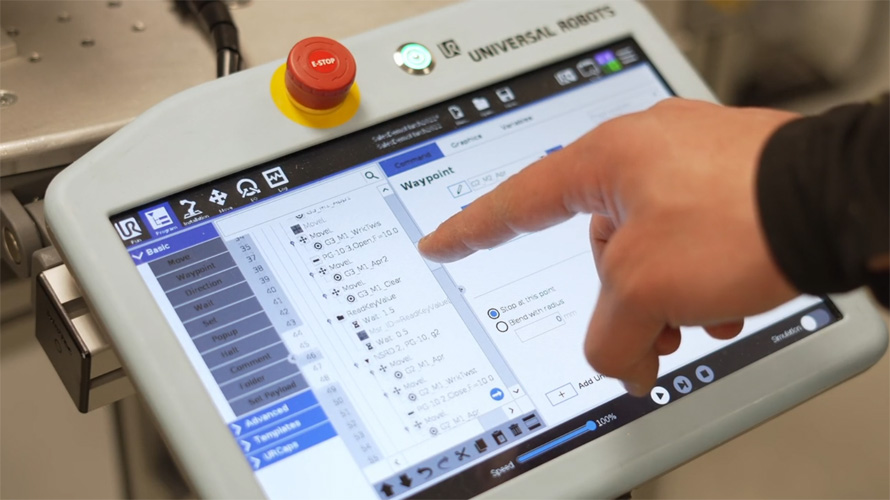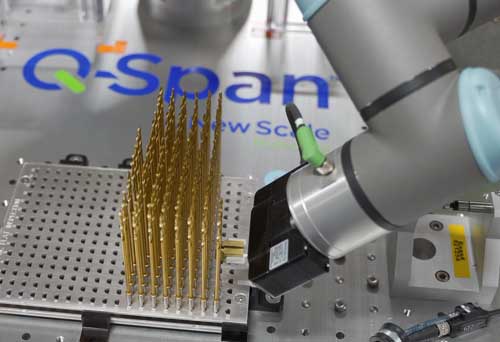What an amazing year 2022 turned out to be! We made the most of our ability to travel and meet manufacturing teams around the country.
Whether touring their machine shops to help them identify automation opportunities, demonstrating our automated gauging systems at trade shows, or participating in the development of new advanced manufacturing workforce training centers – it was great to be out learning about our customers’ needs and introducing them to new possibilities.
Extending what we learned in 2022, we see some key trends extending into the new year:
- Emphasis on quality
- Improving productivity to address manufacturing employee shortages
- Adopting technology to aid in employee retention and job satisfaction
These trends all benefit from introducing collaborative robots (cobots) for automated inspection – both in the QC area, and in-line with or adjacent to the machining centers on the production floor. Let’s take a closer look.
Emphasis on quality
Sometimes this originates with the customer. For example, shops machining parts for medical applications are often required to do 100% inspection.
Sometimes it originates with management. We have met executives keen to reduce the impact of inflation by reducing their costs, and one way is to prevent waste by monitoring machines and adjusting offsets in real time to prevent the production of bad parts.
Many leading machine shops emphasize quality to avoid a “race to the bottom” when competing solely on price.
Finally, for almost all machine shop teams we talk to, an emphasis on quality is a natural result of pride in their work.
In 2023, we see more machine shops taking what they have learned about deploying automation in production and extending that knowledge into new areas of the company. For example, a shop using collaborative robots for machine tending is well positioned to use the same brand of cobots to automate inspection tasks in the quality assurance department.
The Q-Span Automated Gauging System is often the ideal first step in this journey. Using a collaborative robot from Universal Robots, the system is easy to “roll in” to position on the shop floor, near a machining center, and perform 100% inspection of parts as they come off the mill or lathe. Drift in a key measurement such as outer diameter can immediately flag the operator to check the machine and adjust offsets, preventing costly scrap.
We predict increasing use of integration between the Q-Span System and the machining centers, such as automatically adjusting offsets based on the measured data, without operator intervention.
Improving productivity while dealing with employee shortages
We see no end to manufacturing staffing shortages any time soon. One solution is to automate the time-consuming, repetitive tasks. It is difficult for human workers to increase the pace of manual inspection tasks like manual gauging without increasing the risk of errors. Deploying automation for this monotonous task increases the pace and reduces errors, at the same time.
Automation addresses worker shortages in two ways:
First, it is easier for machine shops to attract and retain workers from a smaller pool of potential employees when they can offer more interesting work.
Second, automating the time-consuming tasks improves overall productivity of the existing staff.
Adopting technology to aid employee retention and satisfaction
As we have seen in both machine shops and workforce development centers, manufacturing workers are excited by the opportunity to use the latest technology for advanced manufacturing. With collaborative robots, this technology is within reach of even small- and mid-sized machine shops.
Automated gauging frees employees from the monotony of repetitive measurement tasks. It gives them freedom to move to areas of need throughout the workplace, providing much-valued variety for the employees and giving the management more flexibility.
What’s next for New Scale Robotics
For New Scale Robotics, 2023 will bring continued expansion of the types of gauge measurements and processes that machine shops can automate using a Q-Span System. A Q-Span System currently makes measurements using a robotic calipers or by loading, unloading, and collecting data from LVDT probes, bore gauges, height gauges and more.
We are working with customers who are integrating thread gauges, air gauges and 2D profilers into their Q-Span Systems. We are excited to be working with leading machine shops to identify even more ways they can automate manual inspection to improve quality, productivity, and employee satisfaction in 2023.

Q-Span System roll-out in the machine shop at Orchid Orthopedic Solutions in 2022. With a collaborative robot system, there is no need for special cages or keep-outs and the system can be rolled out – or moved around the shop to perform additional tasks – without the help of a systems integrator.

Automation tools support machine shop goals including (1) emphasis on quality (2) improving productivity to address manufacturing employee shortages, and (3) adopting technology to aid in employee retention and job satisfaction.

The Q-Span System’s gripper picks a surgical drill from a tray, preparing to load it into an LVDT gauge on the shop floor. The robotic gauging system enables automated QC measurements on multiple dimensions of each drill. It reduces the costs of mandatory 100% inspection, and the real-time data can be used to alert manufacturing engineers to tool wear or process drift.
